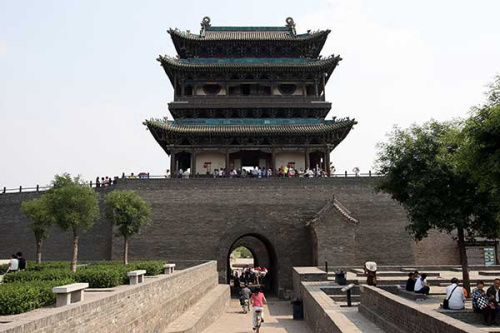
Pingyao ancient town in Shanxi province.(Photo by Wang Zhuangfei)
Of all the colourful tourist attractions our group was taken to on our "Discover Shanxi" trip with China Daily, the one I remember most vividly is the Yungang Grottoes in Datong city. The hutong-like shopping streets in ancient Pingyao are a common sight in Beijing, and China boasts many beautiful temples like those on Wutai Mountain.
However, the countless Buddhist stone carvings that adorn the walls of Yungang's holy caves make them the real jewel of Shanxi heritage for me. It is here that the traditional Chinese style of the Northern Wei Dynasty (AD 386–534) marries Indian Gandhara Buddhist art and it has remained preserved throughout the centuries.
I swivelled around trying to drink everything in. The smooth, pale stone outlined thick lips, open hands and slanted eyes once inlaid with precious stones. The faces of the statues gazed down at me from the higher levels of the caves and I felt like I were being scrutinized by wise old men.
Beautiful carvings dressed walls and ceiling, with paint reapplied during the Qing Dynasty (1644-1911) still bright. The cool breeze and earthy smell inside the caves made their long history very tangible.
The Five Tan Yao caves (Caves 16-20) house huge statues of five emperors of the Northern Wei Dynasty represented as Buddhas. Li Jing, our dedicated local guide, told me a little of their gritty history. The story of Emperor Taiwu (AD 408-452) particularly interested me. He was a devout Taoist who tried to abolish Buddhism.
When he died, his son asked Tan Yao to construct Taiwu's image in Buddhist guise, decorated with a thousand Buddha designs, to represent the Buddhist monks he had killed. Looking at the beautiful 15-meter high statue, I was fascinated by how much time and effort had been put into making a mockery of an emperor that broke with tradition.
In the Five Color Caves, I read the story of the Buddha from images of daily life and rich imperial scenes. There were dancers and teachers, monks and concubines, farmers and lords. The vivid carvings of those scenes had spiritual charm and Lovecraftian grandeur. I asked myself: Do I take photos or do I simply look? How do I describe this to my friends? How do I tear myself away?
The Yungang Grottoes are a masterpiece, a spiritual haven in the dry Wuzhou Mountains. I was awed by the intricacy of the stone structures, the workmanship of the carvers, the expressive Buddha faces, and the ages that they had survived through. I stood looking at each cave for far longer than I realized.
The thousands of carved Buddhas were resilient and quietly smiled at me with encouragement, as if to say "This is what humanity can do. This is what you can do."


















































